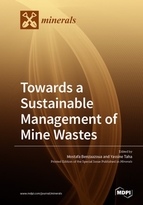Towards a Sustainable Management of Mine Wastes: Reprocessing, Reuse, Revalorization and Repository
A special issue of Minerals (ISSN 2075-163X). This special issue belongs to the section "Mineral Processing and Extractive Metallurgy".
Deadline for manuscript submissions: closed (30 April 2019) | Viewed by 110807
Special Issue Editors
Interests: inorganic industrial and mining wastes; environmental characterization; treatment and recycling of industrial and mining wastes; waste reprocessing; integrated management of mining wastes
Special Issues, Collections and Topics in MDPI journals
Interests: inorganic industrial and mining wastes; environmental characterization; treatment and recycling of industrial and mining wastes; waste reprocessing; integrated management of mining wastes
Special Issues, Collections and Topics in MDPI journals
Special Issue Information
Dear Colleagues,
The need for efficient and sustainable management methods of industrial and mining inorganic wastes is continuously growing all around the world. These wastes often present serious management problems due to their more or less important amounts and possible environmental threats. This Special Issue will include state of the art papers based on works around industrial and mining wastes new trend management techniques. Currently, it is a must to sustainably manage industrial wastes, considering the alternative of creating the maximum of symbiosis and replacing raw material resources by secondary resources. Insights related to industrial and mine waste characterization, landfilling, undergroung backfilling, reprocessing of secondary metal recovery or environmental purposes, valorization in various sectors, etc., are some examples of themes to be included in this Special Issue. Scientists, industry and governance stackholders have to face these new challenges to find the future best management practices.
Main topics:
- Problems around industrial and mine wastes
- Fine characterization of industrial and mine wastes
- Latest available technical and environmental solutions to efficiently manage both types of wastes; treatment and processing before disposal
- High value elements recovery from industrial and mining wastes; towards defining effective, low cost and ecofriendly methods
- Recycling of industrial and mining wastes as alternative resources in different sectors
- Laboratory, pilot and/or industrial scale studies related to these topics
Prof. Dr. Mostafa Benzaazoua
Dr. Yassine Taha
Guest Editors
Manuscript Submission Information
Manuscripts should be submitted online at www.mdpi.com by registering and logging in to this website. Once you are registered, click here to go to the submission form. Manuscripts can be submitted until the deadline. All submissions that pass pre-check are peer-reviewed. Accepted papers will be published continuously in the journal (as soon as accepted) and will be listed together on the special issue website. Research articles, review articles as well as short communications are invited. For planned papers, a title and short abstract (about 100 words) can be sent to the Editorial Office for announcement on this website.
Submitted manuscripts should not have been published previously, nor be under consideration for publication elsewhere (except conference proceedings papers). All manuscripts are thoroughly refereed through a single-blind peer-review process. A guide for authors and other relevant information for submission of manuscripts is available on the Instructions for Authors page. Minerals is an international peer-reviewed open access monthly journal published by MDPI.
Please visit the Instructions for Authors page before submitting a manuscript. The Article Processing Charge (APC) for publication in this open access journal is 2400 CHF (Swiss Francs). Submitted papers should be well formatted and use good English. Authors may use MDPI's English editing service prior to publication or during author revisions.
Keywords
- Inorganic industrial and mining wastes
- Environmental characterization
- Treatment, stabilization, reprocessing and recycling
- Integrated management
- Valorization







